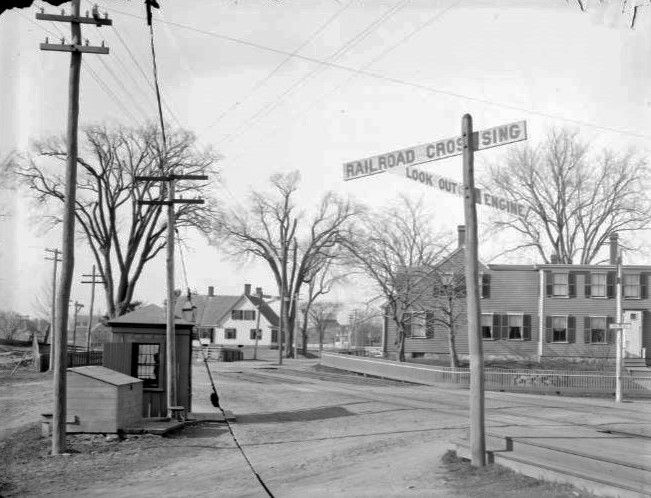Hingham Municipal Lighting Plant, 1911, Incoming Electric Lines into Town, RR Xing
By Joe Maurath, Jr.; posted July 4, 2020
View Original: Click to zoom, then click to magnify (651 x 498) 119KB

|
As discussed previously, this municipal electric utility in Massachusetts purchased their current for their customers and street lights from a privately-owned electric company's generating station right over the town's border in Weymouth, MA. The town's three series street lighting loops also originated there and the company was responsible for maintaining all generation and control equipment. Therefore Hingham had no generation capacity of its own and ultimately wanted to keep it that way (see below). Shown along the right on the taller poles (they had three crossarms) are the primary circuits (either 1,100 or 2,200 volts) and two of the street lighting loops at a location not far from the generation site. From finds through the years and looking closely at old photos, a lot of the insulators used by this utility were CD 134s of differing types. This photo was taken at a railroad crossing and also nicely shows an early threaded telegraph line on shorter poles (strung along the left). For a look of what the predecessor line looked like about a quarter-mile down the tracks: [id=595719200] and [id=595718353]. The threaded insulators appear mostly to be CD 127s. Although I have scouted this line many times I never found any trace of this style although I did find a couple crown-embossed CD 151 Brookfields and a few CD 136 Brookfield B&O's. I strongly suspect the line was once owned by the B&O Telegraph Company. At some point in the teens this route was upgraded with new cedar poles, six-pin crossarms (one per pole) and a variety of insulator styles (nothing rare). When the town purchased the Weymouth Light and Power Company's operation in 1894 in Hingham, "a bond was issued for this acquisition and the building of a generation facility". That bond was for $18,000, paid in full by the end of its 20-year term and was exclusively used for line and equipment that made the town's municipal light system among the most efficient and reliable in the state (according to statements of the time) while the residents enjoyed discounts on bills paid before the 15th of the month along with very fair rates. It was deemed by the Light Plant management and townspeople in 1911 that it would "not be advisable to establish a station...and to confine the business of the department to the *distribution of current* and *not its manufacture*." FYI... Of the 40 municipally-owned light plants here in Massachusetts around a third generate electricity; the rest buy it from the grid for resale to their customers. Of general interest: the general manager, Wallace Corthell, resigned from his position, apparently due to health issues. He commented: "I have collected $205,385.47; uncollected, $81.67. The municipal light board thanked him in their 1911 report, commending "faithful and valuble service...in a most trying position, requiring constant attention night and day...and absolute accuracy and unswerving honesty." In his 1911 year-end report, Mr. Corthell made some kind comments about his experience as manager, with deep, old-school thoughts indicating how people related to each other back in those days: He thanked the Light Board for their "uniform kindness" and added: "The relations that have existed have been such a friendship stronger than usual between employer and employe have resulted, and the memory of which will, to me, be a lasting pleasure." Originally, in 1895, The Hingham Light Board had a vision to reduce electricity costs by 50 percent (in coming years). That goal was achieved in 1911; the rate was 10 cents per kilowatt hour. Electric lighting and appliances continue to gather popularity; 78 new customers were added during 1911, bringing the total to 654. Of further interest, originally (in the early 1890s) there originally was a single 110-200 volt circuit feeding Hingham for lighting customers. This line (and the first two series street lighting loops) was fed from the Weymouth Light and Power Company's generation station in East Weymouth, adjacent to the Back River. From there the supply lines serving the town followed along Fort Hill Street to South Street as in the above photograph. Rebuilt lines with heavier copper wire carrying higher voltages followed soon after the town's ownership along the same stretch, leading to a step-down substation on South Street, opposite from Layfayette Avenue. This station served the town for several decades. In 1891 (when the Weymouth Light and Power Company owned the system) there were 56 street lights on Main Street, 27 on North Street, 20 on South Street, 10 lights on Lincoln Street and one on Spring Street. As the electric light became increasingly popular in subsequent years, many more street lights and customers were added to the Hingham system. Technological advances and efficiencies in delivering electric service in Hingham allowed for rates to be halved in 15 years, thus meeting the goal set by the Light Plant's founders in 1895. If you are familiar with this area this is the start of Fort Hill Street (which was later somewhat straightened) looking southwesterly; West Street is on the right. The house on the right is still there. A public transit station stands where the dwelling in the center stood. |